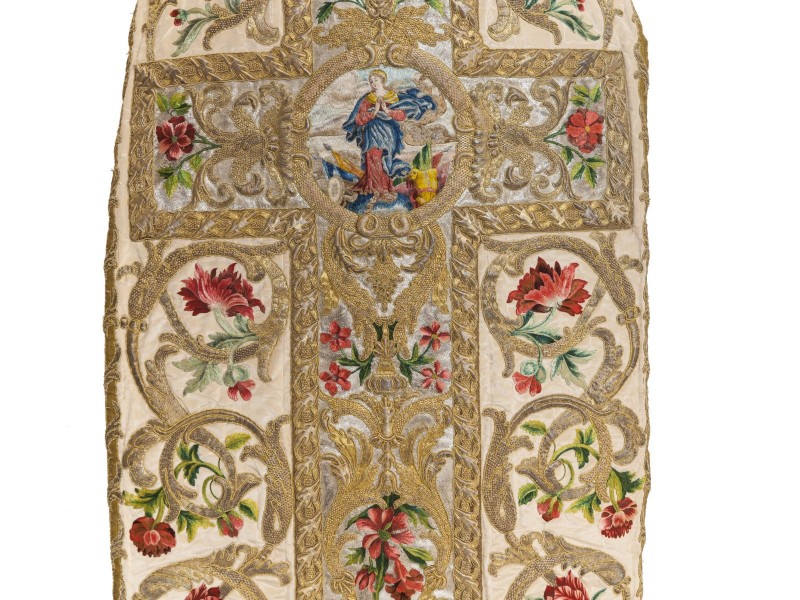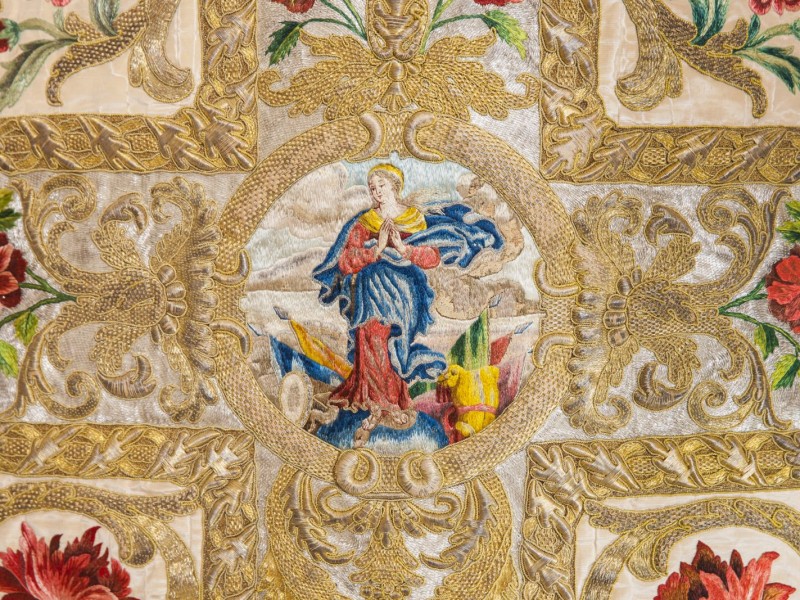The Chasuble of the “Immacolata”, an exclusive preview from the first book of the “Catalogues of the Terra Sancta Museum”
On the occasion of the Marian Month, we offer the description of a precious vestment from the 17th century as a preview of the first volume of the new book series dedicated to the Terra Sancta Museum. “The idea of this Catalogue – tells us Father Stéphane Milovitch (Director of the Cultural Heritage Department of the Custody of the Holy Land) – was born gradually, starting from the study of the liturgical vestments that were exhibited at the Castle of Versailles during the exhibition “The Treasure of the Holy Sepulchre” in 2013, and of those that remained unpublished. Given the quality and quantity of the items, we decided to direct the study towards the publication of a Catalogue of the Vestments of the Custody.”
The book is curated by Maria Pia Pettinau Vescina, an expert in ancient textiles, and it also presents a contribution by Danièle Veron-Dènise, an expert in liturgical and secular embroidery, concerning the embroidered vestments exhibited in Versailles. In addition, Father Milovitch contributed with an essay about tradition and uninterrupted use of the liturgical vestments in the Holy Land. The photographic campaign was carried out by Alfonso Bussolin, Giuliano Mami and Nadim Asfour (CTS).
 The study of the ornament that we propose to you here in preview concerns the chasuble of the Immaculate Conception, according to the wording that was made by the curator Danièle Veron-Denise.
The study of the ornament that we propose to you here in preview concerns the chasuble of the Immaculate Conception, according to the wording that was made by the curator Danièle Veron-Denise.
The liturgical vestment (H 128 cm.; W 72.5 cm.) dates from the end of the 17th century, and it comes from France. It is made of white moiré taffetas with embroideries in gold and silver filé, in gold and polychrome silks. It is executed in couching, with and without wadding (thick strands of linen or hemp), and with various anchoring stitches and long and short stitches, running stitches and French knots. It was registered together with a chalice veil – on account of the obvious stylistic affinities – in several inventories of Saint Saviour’s Monastery between the late nineteenth and the early twentieth centuries.
The cross orphrey of the chasuble has a tondo at the crossing of the arms which contains a luminous figure of Mary Immaculate, derived – as suggested by Danièle Véron-Denise – from an engraving by François de Poilly (Abbeville 1623-Paris 1693). This image on the sacred vestment appears to encapsulate the Marian devotion of the Franciscans and the French (Louis XIII consecrated the Kingdom of France to the Virgin in 1638 upon the birth of his son, the future Louis XIV). However, Jacques Charles-Gaffiot considers it more plausible that the inclusion of trophies and flags at the feet of the Virgin refers to a victory of the armies of Louis XIV over enemy soldiers. He discerns an allusion to François-Henri de Montmorency (1628-1695), Duke of Luxembourg and marshal of France, who was nicknamed “Le Tapissier de Notre-Dame”. After his three great victories over William III of Orange (including that at the Battle of Steenkerque in 1692) the marshal sent numerous captured standards to the Cathedral of Notre-Dame in Paris, where they were hung from the ceiling of the choir.
Consequently, it is understandable that the Virgin, the patron of France, would be shown with the banners of a Protestant enemy army at her feet. Indeed the entire ornamentation, on account of its symbolic and artistic value, is a hymn to the Virgin. The weight of the gold and silver threads is almost absorbed by the tulips, rose-like flowers and corollas with many petals that illuminate with red the acanthus-shaped volutes of the side panels and the decorations of the cross and pillar orphreys standing out against the grounds of silver filé. Although in many interpretations of coeval painting the flower symbolises vanities, here, along with the acanthus, it is the symbol of rebirth and, through the Virgin, the colour refers to the blood shed by Christ. This is again confirmed by the acanthus, the small leaves of which complete the decoration of the outer border in relief.
As is evident from this description, the catalogue will present a “treasure” that has remained largely, and for a long time, hidden and unknown, but very well preserved in the ample chests of drawers of the sacristies of the Franciscan monasteries. Some aspects will come to light, as the author explains, “that will be of special interest for the Fathers of the Custody itself, because they will help them to better understand what has been preserved of the precious gifts received from Europe through the centuries, and also what has been lost, not because of neglect but from a number of causes.
The descriptions will follow in chronological order, based on the date of the arrival – recorded or deduced – of the liturgical vestments, covering a span of time from the 16th to the 20th centuries. A scientific approach was used to describe the historical, stylistic, symbolic, and technical aspects of the items, and the numerous inscriptions and coats of arm that were present, relating these – wherever possible – to information available in documents from the Archive. The use of precious documents, in particular the so-called “Registers of Conduct” and the inventories of the sacristies, has been fundamental in the research. On the one hand, these sources supported attributive hypotheses and, on the other hand, they convey the living history of the vestments, the history of their devotional origin and liturgical function, and that of their constant care by the Franciscans. So many elements that, like precious threads, weave the historical context, becoming the warp and weft of the relationship between the great European powers and the Holy Land. A useful help for the readers are the glossaries concerning the typology, the use and function of the liturgical vestments, the symbolism of the liturgical colours, and the definitions of materials and weaving techniques.
The editorial project of the new book series published by ETS for the Terra Sancta Museum is expected to present in the future the cultural heritage of the Custody of the Holy Land through monographic books about: Silverware, Mother of Pearl, Illuminations of the corals preserved by the General Library of the Custody, and Paintings.
The book series will be anticipated in September by a “Number 0”, edited by Sara Cibin, presenting a selection of works (50 from the archaeological collection and 50 from the historical one) that will serve as a preview and a celebration of the most important works of the Museum.



